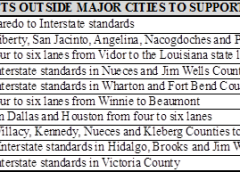Transportation improvements are needed to address deficient, crowded or congested roads, highways and bridges in Texas that threaten to stifle the state’s economic growth and development. This is according to a new report released by TRIP, a Washington, DC based national transportation research organization.
The report, “Texas’ Most Critical Highway Projects to Support Economic Growth and Quality of Life,” identifies the 100 highway improvements most needed to support economic growth and quality of life in Texas, ranked in order as determined by TRIP. These improvements include projects to build, expand or modernize highways or bridges throughout the state in order to accommodate projected job growth and population increases.
Making these needed transportation improvements would enhance Texas’ economic development, support a high quality of life, and accommodate projected future growth in population and economic activity. Texas led the nation in job creation in each of the last five years, and the state is expected to add 3.5 million residents in the next 20 years.
Completion of these projects would increase mobility and freight movement, ease congestion, improve safety, and ensure Texas remains an attractive place to live, visit and do business. A lack of adequate transportation funding is the constraining factor in developing and delivering these needed improvements.
The TRIP report identifies the most needed improvements in Austin, Dallas-Fort Worth-Arlington, Houston, San Antonio and other locations in Texas. The 10 most needed transportation improvements to support economic growth in areas outside the state’s four largest urban areas are detailed below.
TRIP identified and evaluated each project based on the following criteria: short-term economic benefits, including job creation; the level of improvement in the condition of the transportation facility, including safety improvements; the degree of improvement in access and mobility; and, the long-term improvement provided in regional or state economic performance and competitiveness.
“Proposition 1 was a clear message from Texas voters that they believe funding our highways is a very high priority,” said Brandon Janes, chairman of Transportation Advocates of Texas. “We are seeing community leaders across the state urging members of the Legislature to take the next step in addressing the state’s highway funding shortfall. Our member organizations believe a significant part of the solution will be for lawmakers to approval a reliable, constitutionally dedicated funding mechanism like SJR 5 or HJR 13. Either approach will provide more than $2.5 billion a year in sustained funding and will keep our state from falling further behind on congestion, connectivity, safety and deteriorating roadways.”
According to the TRIP report, 15 percent of Texas’ major roads are in poor condition, while 41 percent are in mediocre or fair condition and the remaining 44 percent are in good condition.
Texas’ overall traffic fatality rate of 1.38 fatalities per 100 million vehicle miles of travel in 2013 is significantly higher than the national traffic fatality rate of 1.09. The fatality rate on Texas’ rural non-Interstate roads was 2.48 fatalities per 100 million vehicle miles of travel in 2013, nearly two-and-a-half times higher than the 1.04 fatality rate on all other roads and highways in the state.
Enhancing critical segments of Texas’ transportation system will boost the state’s economy in the short-term by creating jobs in construction and related fields. In the long-term these improvements will enhance economic competitiveness and improve quality of life for the state’s residents and visitors by reducing travel delays and transportation costs, improving access and mobility, improving safety, and stimulating sustained job growth. Sustaining Texas’ long-term economic growth and maintaining the state’s quality of life will require increased investment in expanding the capacity of the state’s transportation system, which will enhance business productivity and support short- and long-term job creation in the state.
“Investing in Texas’ transportation system and addressing these challenges by improving the condition and efficiency of the state’s roads, highways and bridges will be an effective step in boosting the state’s economy, enhancing quality of life and accommodating future growth,” said Will Wilkins, executive director of TRIP.

